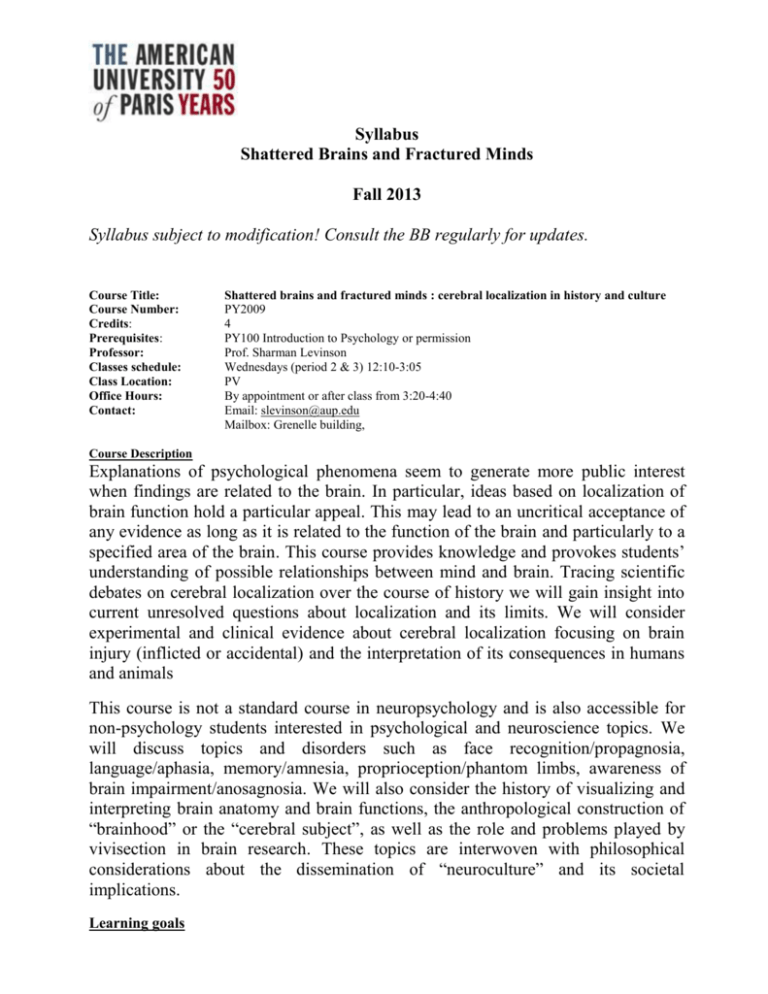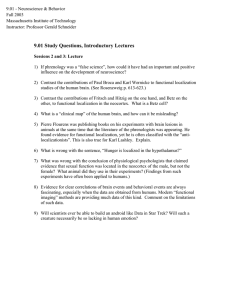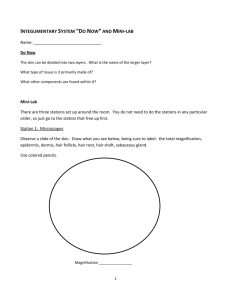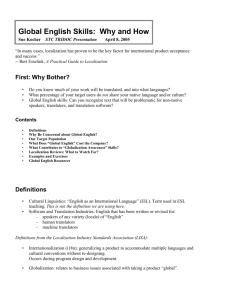The American University of Paris
advertisement

Syllabus Shattered Brains and Fractured Minds Fall 2013 Syllabus subject to modification! Consult the BB regularly for updates. Course Title: Course Number: Credits: Prerequisites: Professor: Classes schedule: Class Location: Office Hours: Contact: Shattered brains and fractured minds : cerebral localization in history and culture PY2009 4 PY100 Introduction to Psychology or permission Prof. Sharman Levinson Wednesdays (period 2 & 3) 12:10-3:05 PV By appointment or after class from 3:20-4:40 Email: slevinson@aup.edu Mailbox: Grenelle building, Course Description Explanations of psychological phenomena seem to generate more public interest when findings are related to the brain. In particular, ideas based on localization of brain function hold a particular appeal. This may lead to an uncritical acceptance of any evidence as long as it is related to the function of the brain and particularly to a specified area of the brain. This course provides knowledge and provokes students’ understanding of possible relationships between mind and brain. Tracing scientific debates on cerebral localization over the course of history we will gain insight into current unresolved questions about localization and its limits. We will consider experimental and clinical evidence about cerebral localization focusing on brain injury (inflicted or accidental) and the interpretation of its consequences in humans and animals This course is not a standard course in neuropsychology and is also accessible for non-psychology students interested in psychological and neuroscience topics. We will discuss topics and disorders such as face recognition/propagnosia, language/aphasia, memory/amnesia, proprioception/phantom limbs, awareness of brain impairment/anosagnosia. We will also consider the history of visualizing and interpreting brain anatomy and brain functions, the anthropological construction of “brainhood” or the “cerebral subject”, as well as the role and problems played by vivisection in brain research. These topics are interwoven with philosophical considerations about the dissemination of “neuroculture” and its societal implications. Learning goals At the end of this course I would like you to able to: Describe relationships between brain damage in different parts of the brains and behavioral abnormalities. Express ideas about the brain’s role in organizing bodily perception, and discuss ideas about the relationship between the brain and the “self”. Describe the brain’s involvement in different types of remembering and forgetting Discuss ideas on how we recognize faces and objects. Describe evidence for conscious and unconscious perception and give examples for brain systems involved in this Describe how the brain is involved in language and what the evidence is for this Retrace important events in the history of debates on cerebral localization, and be able to explain why the history of these debates is relevant to neuroscience today Understand the importance but also the limits of single case studies for cerebral localization Understand the contributions of vivisection to neuroscience and neurpsychology but also the ethical issued raised by vivisection Have notions of the history of neuroimaging and be able to discuss questions concerning interpretation Have notions of the relationship of neuroscience and neuropsychology to other disciplines Furthermore I would like you to: Further develop presentation skills. Practice skills involved in conducting a literature search. Further develop critical thinking skills. Further develop writing skills and learn Be able to develop a clear argument Grading Final grades will be based on the following factors (all having equal weight): Class participation – this is a discussion class so you MUST participate. You will be graded on the effort. Be prepared to discuss: o Readings required up to the lecture day (chapters, articles) o Any articles of interest to the discussion topic (from popular media to scientific journals) – remember your source of course. o I will recommend some blogs you can follow so we can also stay informed of current neuroscience discussions, you should take a look at these blogs periodically Warning! If I am not satisfied that you have been doing the readings I reserve the right to conduct pop-quizzes. Presentation on a Neurological Disorder: Each student will give an 15 minute presentation of a case study on a patient with brain damage (or mental disorder that can be related to the brain, including neurodegenerative disorders). The student has to report on neuroscience literature (at least 5 primary scholarly sources) that deals with explanations of the phenomena found in this particular case study/(or possibly case studies but focus on one in particular, the student must also link the discussion to readings in class including historical readings. You presentation should include power point and all power point slides are due on October 9 th independently of the presentation date!!! Paper on a ‘Neurophilosophical’ Topic: Each student will write a 15 page paper (double spaced, 12 point Times New Roman font) on a topic that combines neuroscience with philosophy, sociology, technology, art, literature or other non-psychology, non-neuroscience field. Possible topics are: the internet and the brain, consciousness/ illusion of reality, emotion and reason, neuroculture, neuro aesthetics, religiosity and the brain. A complete bibliography will be requested by each student by November 9 for my approval. The final paper must use the same sources as listed on the approved bibliography. Depending on the topic the number of sources can vary but a minimum of 8 must be used and no more than 12. In addition to these sources you should also refer to the historical and philosophical readings assigned for class. Important: The quality of your presentation and your paper is crucial to your grade. Papers and presentations should be submitted in a finished form, demonstrating well-thought out arguments, providing supporting evidence for your arguments, providing sources (that you have read), and must be written in a clear voice. You are asked to use APA 6th edition style. This means that I do not want any stream of consciousness papers that have not been spellchecked. There is a Writing Lab on campus (in this building) that can help you out and so can I. Reading schedule subject to modification, possibility of museum visits TBA READINGS CAN BE FOUND ON BB Septembre (Historical and philosophical background) S1 S2 S3 11 Presentation of course and objectives Discussion of students representations of the brain and expectations for the course Read : Brainhood, Anthropological Figure of Modernity, Cardiocentric Physiology the persistence of a delusion 18 Lecture and Discussion of Brainhood, the “cerebral subject” and “neurochemical selves” Read: Brain Physiology and the Mind in the Nineteenth Century 25 Lecture and Discussion of Brain Physiology and Mind Presentation of Basic Relevant Brain Antomy and consequences of Brain Injury to different areas Read : Cortical Localization Octobre (Cortical Localization : Discoveries and Debates) S4 S5 S6 S7 2 Lecture and Discussion of the History of Cortical Localization Read Localization of Language Function, Leborgne 9 The case of Broca’s famous patient “Tan” Student Presentations on Neurological disorders or Cases Read Holism and Criticism of Cortical Localization 16 Lecture : Holism and Cortical Localization : a scientific and political issue, discussion of the debate and current perspectives Student Presentations on Neurological disorders or Cases Read Phineas Gage and the Frontal Lobes and Intellect 23 Lecture and discussion : Phineas Gage yesterday and today, presentation of original documents. We will analyze these documents together in class Student Presentations on Neurological disorders or Cases Read H.M. Articles Novembre (Case Studies and Neuronarratives) S8 6 Lecture on H.M and memory, Discussion of H.M. case S9 S10 S11 Read the Man who mistook his wife for a hat, and history of agnosia 13 Discussion of the Man who mistook his wife for a hat, agnosia, propagnosia, the “neuronarrative” and its diffusion Read Ramachandran on Phantom Limbs and (optional : phantom penis), read about early mirror therapy 20 Lecture and Discussion of Phantom Limbs, therapeutic perspectives Read Sacks the disembodied Lady 27 Discussion of Brain, Body and Self in relation to the Disembodied Lady and Phantom Limbs Read Ramachandran on Capgras’ sydrome Décembre S12 4 Lecture and Discussion Capgras his case : L'Illusion des sosies dans un délire systématisé chronique (we will discuss distinctions between organic and psychogenic etiologies) S13 11 Traumatic Brain injury in Film Film session (the Lookout) S14 18 Discussion of Final Papers Hand in Final Paper Today !! The bibliography for this class can be found in a separate document that you can consult on the BB. Any articles suggested by students can be added to the BB and bibliography with my permission, these suggestions can be readings related to your presentation of final paper.







